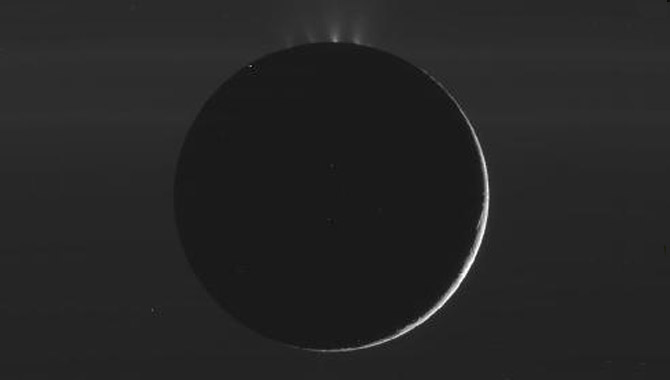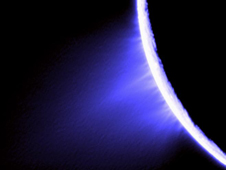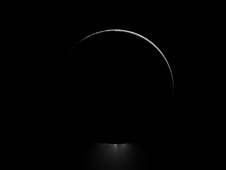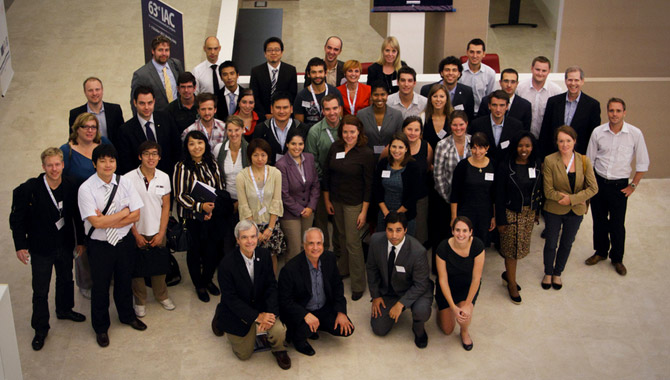
Vol. 5, Issue 10
Initially a mission to deliver the Huygens probe to Titan, the Cassini spacecraft delivered an additional, unexpected discovery.

This raw image of Saturn’s moon Enceladus was taken by NASA’s Cassini spacecraft on Dec. 20, 2010. The spacecraft was approximately 158,000 kilometers (98,000 miles) away from Enceladus.
Photo Credit: NASA/JPL/SSI
Fifteen years ago this month, the Cassini spacecraft was launched from Cape Canaveral atop an Air Force IVB/Centaur rocket. What began as a mission to deliver the Huygens probe to Titan, Saturn’s largest moon, and explore the Saturn system resulted in a dramatic finding: one of Saturn’s smaller moons, thought to be frozen solid, may harbor the potential for life.
Saturn’s sixth-largest moon, Enceladus, was first observed in 1789 by astronomer William Herschel. Nearly two hundred years later, the Voyager spacecraft observed a unique feature of Enceladus: though only 310 miles in diameter—less than the distance between Los Angeles and San Francisco—it is the most reflective object in the solar system. Because Enceladus reflects nearly all of the sunlight that reaches it, scientists expected it would be extremely cold.
Instead, more than 20 years after Voyager spotted the bright moon, Cassini’s composite infrared spectrometer (CIRS) revealed that the south polar region of Enceladus is considerably warmer than anticipated. This unexpected warmth is powered by heat escaping from the moon’s interior: Enceladus, like Jupiter’s moon Io and Neptune’s moon Triton, is geologically active.
According to data and images gathered by Cassini, Enceladus emits a plume of icy particles from jets, or geysers, along its south pole. The plume, made up of ice water and vapor as well as organic compounds, is powerful and extends far beyond the surface of the moon. Nearly 200 pounds of water vapor are ejected per second from long cracks in the ice—known as “tiger stripes”—along the moon’s southern polar region. This plume is a major contributor to Saturn’s largest ring, known as the E-ring.

Cassini imaging scientists used views like this one to help them identify the source locations for individual jets spurting ice particles, water vapor and trace organic compounds from the surface of Saturn’s moon Enceladus.
This false-color view was created by combining three clear filter images taken at nearly the same time as Fountains of Enceladus – Image 2. This image product was then specially processed to enhance the individual jets that compose the plume.
Photo Credit: NASA/JPL/SSI
Given its source of heat, the complex organic chemicals present in its plume, and the potential for liquid water beneath its surface, Enceladus is emerging as the most likely candidate to support life beyond Earth. Such life would have to exist below the surface of the moon, without sunlight or oxygen. But recent findings on Earth suggest that microbes can survive without these components. Energy produced by the chemical interaction of different rocks or from radioactive decay in rocks has been shown to support bacteria. Such bacteria—or something similar—might thrive in the conditions within Enceladus.
Despite all that Cassini has revealed about Enceladus, much more must be known before anything concrete can be determined about its potential to support primitive life forms. Fortunately, extensions to the original Cassini Mission have made it possible to continue to explore the characteristics of Enceladus for the next five years.
The original Cassini Mission terminated in 2008. At that point, an extended mission—called the Cassini Equinox Mission—gave scientists the opportunity to further explore the Saturn system. At the end of that mission, in September 2010, NASA approved a second mission extension: the seven-year Cassini Solstice Mission. Expected to continue through September 2017, this mission is distinct from earlier Cassini missions in several ways.
The Solstice Mission will allow scientists to explore the Saturn system in midsummer, when its northern poles are illuminated by sunlight. Exploring the Saturn system under summer conditions will allow scientists to learn more about seasonal changes on the planet and its larger moons. The mission will maximize flybys for Titan and Enceladus to learn about weather system changes on the larger moon and geyser changes—as well as associated effects on Saturn’s E-ring, which is fed by the Enceladus geysers—on the smaller moon.
The Solstice Mission will use far less fuel than earlier missions. By October 2010, 80% of Cassini’s propellant was spent. Because of this, the new seven-year mission had to proceed using one-quarter the fuel that supported the previous six years of Cassini’s voyage. Fortunately, Cassini’s tour designers were able to shape a trajectory for the final mission that allows meaningful exploration of the Saturn system, including 11 additional Enceladus flybys, while consuming relatively little fuel. The spacecraft will use its 12 instruments to further map Enceladus’s gravity, penetrate more deeply into its geysers, and explore the northern hemisphere of the moon.

Below a darkened Enceladus, a plume of water ice is backlit in this view of one of Saturn’s most dramatic moons.
Photo Credit: NASA/JPL-Caltech/SSI
Flybys on April 28, 2010, November 30, 2010, and May 2, 2012 were conducted to learn more about the internal structure of Enceladus. On the first flyby, a Cassini Radio Science Subsystem (RSS) experiment sought out anomalies in the mass beneath the south pole in an attempt to locate the plume’s source material. The experiment required 30 hours of ongoing Deep Space Network support and included gravity observations to explore two hypotheses regarding the interior of Enceladus, including the concept of an ocean beneath a layer of surface ice.
Flybys on October 1, 2011, March 27, 2012, and April 14, 2012 provided extensive coverage of Enceladus’s southern region. Cassini’s ion and neutral mass spectrometer (INMS) “tasted”—sampled—the plume’s particles to learn more about their composition, density, and variability. The flybys in March and April were the lowest yet over the south pole (just 46 miles above the surface). A closer pass above the same region will be conducted in 2015, when Cassini is expected to travel 30 miles above the pole.
Cassini will continue to explore Enceladus, Titan, and several other Saturn moons throughout the summer solstice. In April 2017, the spacecraft will pass closely by Titan to get a gravity assist “slingshot” that will put it inside Saturn’s closest ring. Seven months later, a final Titan flyby will send the spacecraft into Saturn’s atmosphere, where it will terminate on impact. This last step is crucial: Cassini must not be left unpowered in the Saturn system, where it could crash into Titan or Enceladus and potentially contaminate either moon.
Read an interview with Cassie Conley about the Planetary Protection Office.









